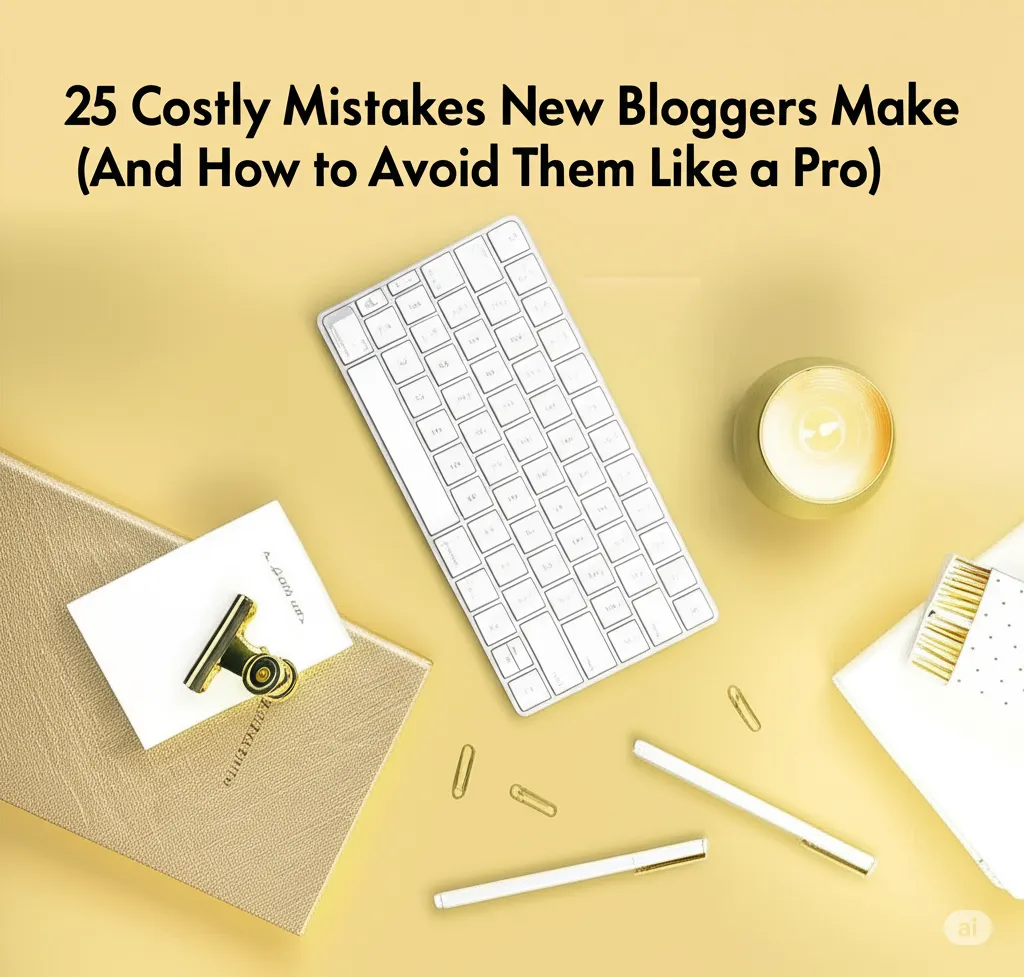Starting a blog can be an exciting journey, a chance to share passions, expertise, or unique perspectives with the world. However, the path to blogging success is often dotted with common pitfalls that can trip up even the most enthusiastic new bloggers. Many aspiring writers dive in without a clear strategy, leading to frustration and, often, an early exit from the blogging scene. This article will explore 25 costly mistakes new bloggers frequently make and, more importantly, offer actionable tips and advice on how to sidestep them like a seasoned professional.
Getting Started on the Wrong Foot
The initial steps in blogging are crucial. Setting a strong foundation can make all the difference in a blog’s long-term viability and growth.
Not Defining a Clear Niche
One of the most significant early missteps for new bloggers is choosing the wrong niche or, conversely, being too general. Without a focused area, content can become scattered, making it difficult to attract and retain a dedicated audience. It’s like trying to be a jack-of-all-trades but a master of none. Instead of broadly covering “lifestyle,” consider something more specific like “sustainable urban gardening” or “budget travel for digital nomads.” The key is to find a balance—a niche that is specific enough to allow for differentiation, yet broad enough to offer a steady stream of content ideas. When picking a niche, aspiring bloggers should align it with their passions and knowledge while also ensuring there’s an interested audience.
Choosing the Wrong Blogging Platform
The platform on which a blog is built is its backbone. Many new bloggers make the mistake of not thoroughly researching their options, opting for convenience over functionality and scalability. Platforms like Blogger or Medium might seem easy to start with, but they often come with limitations in terms of customization, content control, and monetization capabilities. This can lead to technical headaches, limited growth, and potentially the need for a costly and time-consuming migration later. Experts often recommend self-hosted WordPress.org for its flexibility, vast plugin ecosystem, and complete control over the blog’s future
Ignoring Branding Early On
A blog is more than just a collection of articles; it’s a brand, and utilizing platforms like Pinterest can enhance its visibility and engagement. Ignoring branding in the early stages is a common oversight. Without a clear identity—a consistent visual style, tone of voice, and overall personality—a blog can struggle to stand out in a crowded online space. This can lead to audience confusion, a lack of professionalism, and missed opportunities for recognition and collaboration. Establishing a unique brand identity from the outset helps build credibility, fosters recognition, and makes the blog memorable to its target audience
Planning and Strategy Blunders
Even with a clear niche, success hinges on effective planning and strategic execution.
Skipping Audience Research
A blog exists for its readers. Therefore, not understanding audience needs and preferences is a fundamental mistake. New bloggers often write about topics that only interest them, failing to connect with their potential readership. This leads to unfocused content, low engagement, and ultimately, a failure to build a loyal following. Conducting thorough audience research, defining target personas, and tailoring content to address their pain points, interests, and questions ensures that every post resonates deeply with the intended readers.
Not Setting SMART Goals
Many new bloggers embark on their journey without defining clear, actionable goals. Ambiguous objectives like “get more traffic” or “make money” are too vague to be effective. This can lead to misaligned efforts, demotivation, and burnout. Successful bloggers set SMART goals: Specific, Measurable, Achievable, Relevant, and Time-bound. For instance, “Increase organic traffic by 20% within six months by publishing two SEO-optimized posts per week” is a SMART goal that provides clear direction and a way to track progress.
Lacking a Content Calendar
Consistency is key in blogging, and a lack of planning can quickly lead to inconsistent blogging. Without a content calendar (also known as an editorial calendar), bloggers often find themselves scrambling for ideas, leading to irregular posting schedules, missed opportunities for seasonal content, and inefficient resource allocation. A well-planned content calendar helps maintain a consistent publishing schedule, ensures a balanced mix of topics, and allows for strategic content planning around holidays, events, or product launches.
Content Creation Mistakes
The heart of any blog is its content, and writing plays a crucial role in its execution. Even with perfect planning, poor execution in content creation can derail efforts.
Writing Without Purpose
Every blog post should have a clear objective. Writing without purpose, merely to fill space, alienates readers and wastes effort. Content should aim to inform, entertain, solve a problem, or persuade. Before typing a single word, bloggers should ask themselves: “What is the goal of this post?” and “What value does it provide to my audience?”
Focusing Only on Quantity Over Quality
The misguided belief that more content is always better leads many new bloggers to prioritize quantity over quality. Publishing a high volume of shallow, unengaging, or poorly researched posts can turn readers away and hurt the blog’s credibility and SEO. Search engines increasingly favor comprehensive, valuable, and unique content. It’s far better to publish one exceptionally well-written, insightful article a week than several mediocre ones.
Neglecting SEO Best Practices
Many new bloggers overlook the critical role of Search Engine Optimization (SEO) from the outset. Ignoring keyword research, on-page optimization, and technical SEO elements means their valuable content may never be discovered by search engines. This results in low organic traffic, regardless of how good the content is. Implementing SEO best practices from day one, including thorough keyword research, optimizing titles and meta descriptions, and ensuring mobile responsiveness, is crucial for long-term visibility.
Design and User Experience Issues
A blog’s design and user experience (UX) are just as important as its content. They dictate how easily visitors can consume information and navigate the site.
Using Cluttered or Outdated Themes
A blog’s theme sets the first impression. Using a cluttered, outdated, or visually unappealing theme can instantly deter visitors. Such themes often lead to slow loading times, poor navigation, and an unprofessional appearance, resulting in high bounce rates. Choosing a clean, professional, and regularly updated theme that prioritizes user-friendliness and consistent design is essential for a positive user experience.
Ignoring Mobile Responsiveness
With the majority of internet users accessing content on mobile devices, ignoring mobile responsiveness is a critical error. A blog that doesn’t adapt well to different screen sizes will provide a frustrating experience for mobile users, leading to higher bounce rates and negatively impacting SEO, as Google prioritizes mobile-first indexing. Ensuring the blog’s design is fully responsive is non-negotiable in today’s digital landscape.
Poor Navigation and Layout
If visitors can’t easily find what they’re looking for, they’ll leave. Poor navigation—complex menus, unclear categories, or a disorganized layout—creates frustration and shortens site visits. An intuitive and straightforward navigation system, clear content organization, and a balanced layout are vital for a positive user experience, encouraging visitors to explore more of the blog’s content.
Promotion and Marketing Pitfalls
Creating great content is only half the battle; promoting it effectively with practical tips is equally important.
Not Leveraging Social Media
Many new bloggers fail to fully utilize the power of social media for content promotion. Simply publishing a post and hoping people find it is a recipe for slow growth. Not actively promoting blog content on relevant social media platforms like Pinterest means missing out on significant reach and engagement opportunities. Identifying where the target audience spends their time online and strategically sharing content there can dramatically increase visibility.
Avoiding Email Marketing
Neglecting to build an email list is a common and costly mistake. While social media provides reach, email marketing builds a loyal audience and offers a direct line of communication with readers. Avoiding email marketing means missing out on a powerful tool for driving repeat traffic, nurturing relationships, and announcing new content or offers directly to interested subscribers.
Relying Only on Organic Traffic
While organic search traffic is valuable, relying solely on it for growth is a slow strategy. A diverse promotion strategy that includes social media, email marketing, guest posting, and potentially paid promotion or collaborations can accelerate growth and broaden reach. Putting all eggs in one basket leaves a blog vulnerable to algorithm changes and limits its potential audience.
SEO and Technical Oversights
Even with good content, technical mistakes can hinder a blog’s visibility in search engines.
Not Submitting Sitemap to Search Engines
A sitemap acts as a roadmap for search engines, helping them discover and index all the important pages on a blog. Failing to create and submit an XML sitemap to search engines (via tools like Google Search Console) can lead to slower indexing, particularly for new or large sites, meaning valuable content may take longer to appear in search results.
Ignoring Meta Descriptions and Titles
Meta descriptions and title tags are crucial SEO elements that influence click-through rates from search results. Ignoring them, or having duplicate and unoptimized ones, can result in less compelling search snippets, reducing the chances of users clicking on the blog’s link. Crafting unique, clear, concise, and keyword-rich meta descriptions and title tags for each page is essential for attracting searchers.
Not Compressing Images for Speed
Large, unoptimized images are a major culprit for slow page load times. In an age where users expect lightning-fast websites, slow loading due to heavy images leads to high bounce rates and negatively impacts SEO (especially Core Web Vitals). Compressing and resizing images before uploading them, and choosing appropriate file formats, can significantly improve site speed and user experience
Monetization Misjudgments
Many bloggers aim to monetize their passion, but doing so incorrectly can backfire.
Trying to Monetize Too Early
One of the biggest mistakes is focusing on generating income before building a loyal audience and providing consistent value. Trying to monetize too early can alienate readers and damage trust. A blog needs to establish itself as a valuable resource and build a community before successfully integrating monetization strategies. Prioritizing value and audience building will naturally lead to monetization opportunities.
Overloading with Ads
While ads can be a source of income, overloading a blog with too many intrusive advertisements creates a poor user experience. Excessive ads can distract readers, interrupt their flow, slow down the site, and ultimately drive them away. Strategic and sparse ad placement, prioritizing user experience over maximizing immediate ad revenue, is a far more sustainable approach
Ignoring Affiliate Marketing Opportunities
Affiliate marketing can be a lucrative revenue stream when done correctly. Many new bloggers overlook or fail to properly leverage affiliate partnerships within their niche. Integrating affiliate links naturally into valuable content that genuinely helps readers, coupled with clear disclosure, can provide significant income without being overly intrusive
Consistency and Discipline Issues
Blogging, like any form of writing, is a marathon, not a sprint, requiring dedication and consistency.
Inconsistent Posting Schedules
As mentioned earlier, inconsistent blogging is a major problem. Irregular posting can lead to a loss of reader interest and difficulty in building a loyal following. Readers appreciate predictability. Sticking to a regular publishing schedule, even if it’s less frequent (e.g., once a week), builds anticipation and encourages return visits
Giving Up Too Soon
Perhaps the most common and costly mistake of all is giving up too soon. Blogging success rarely happens overnight; it takes consistent effort, patience, and persistence. Many new bloggers get discouraged by slow growth or a lack of immediate results and abandon their efforts before their blog has a chance to flourish. Understanding that blogging is a long-term commitment and celebrating small victories can help maintain motivation.
Not Tracking Performance Metrics
Flying blind without tracking key performance metrics is akin to driving without a dashboard. Not monitoring subscriber growth, blog views, top-performing posts, and SEO performance means bloggers can’t make data-driven decisions. Regularly analyzing metrics using tools like Google Analytics helps identify what’s working, what’s not, and where to focus efforts for maximum impact.
Community and Networking Mistakes
Blogging is also about connecting with others in the same space.
Not Engaging with Readers
A blog is a conversation, not a monologue. Failing to engage with readers through comments, social media, or email can lead to a lack of community and make readers feel disconnected. Responding to comments, asking questions, and fostering dialogue builds a loyal and engaged audience.
Avoiding Collaboration with Other Bloggers
Operating in isolation limits a blog’s reach and growth potential. Avoiding collaboration with other bloggers, brands, or influencers means missing out on opportunities for cross-promotion, valuable backlinks, and expanding an audience. Active collaboration can introduce a blog to new readers and build authority within the niche.
Not Participating in Niche Communities
Relevant online communities (forums, social media groups, Pinterest, online courses) are goldmines for insights, networking, and audience engagement. Not participating in these niche communities means missing out on opportunities to learn from peers, establish oneself as an authority, and connect with potential readers and collaborators.
Legal and Ethical Missteps
Overlooking legal and ethical considerations can lead to serious consequences.
Using Copyrighted Content Without Permission
A serious mistake is using copyrighted images, text, or other media without proper licensing or permission. This can lead to severe legal penalties and irrevocably damage a blog’s credibility and reputation. Always use royalty-free content, obtain proper licenses, or, ideally, create original material.
Not Disclosing Sponsored Content or Affiliate Links
Transparency is paramount. Failing to clearly disclose sponsored content or affiliate links damages trust with the audience and can lead to legal penalties, especially with regulations like those from the FTC. Always disclose these relationships clearly and prominently to maintain credibility and comply with legal requirements.
Related Internal Links (Reads You May Like):
- Affiliate Marketing: The Ultimate Guide in 2025 [Expert Insights + Proven Tips]
- Start Dropshipping with No Money: A Beginner’s Guide
- Chrome Extensions for Workflow: Boost Productivity
- Top 10 AI Image Generators for Beginners (Free & Paid)
FAQs About Blogging Mistakes
Here are some common questions new bloggers often have about mistakes and recovery:
What is the #1 mistake new bloggers make?
While many mistakes can derail a blog, not defining a clear niche and skipping audience research are arguably the most foundational errors, as they lead to a lack of direction and an inability to connect with readers. However, giving up too soon often prevents any blog from succeeding, regardless of its initial setup.
How long does it take to see results from blogging?
Blogging is a long-term game. While initial views might appear within 3 to 9 months, significant traffic, a strong audience, or substantial monetization can often take over a year of consistent effort. It truly is a marathon, not a sprint.
Can I recover from early blogging mistakes?
Absolutely! Most blogging mistakes can be rectified. The key is to learn from them, adapt strategies, and consistently implement best practices, including following useful tips. It’s never too late to refine your niche, improve your content, or optimize your SEO.
Should I delete old blog posts that didn’t perform well?
Often, it’s more beneficial to update and improve (or “salvage”) old content rather than deleting it. Refreshing outdated information, optimizing for SEO, and enhancing readability can give old posts a new lease on life. Deletion should be a last resort, usually reserved for truly irrelevant or unsalvageable content.
Do I need to learn SEO as a beginner blogger?
Yes, learning basic SEO is crucial from day one. Understanding keyword research, on-page optimization, and technical SEO elements is fundamental for making your blog discoverable and attracting organic traffic. High-earning bloggers consistently prioritize SEO.
How often should I post as a new blogger?
Quality and consistency trump quantity. It’s better to publish one high-quality, well-researched post per week consistently than to publish several rushed, mediocre articles irregularly. Aim for a schedule you can realistically maintain without sacrificing content quality.
Conclusion: Learn, Adapt, and Grow
Blogging is a journey of continuous learning, adaptation, and writing. While new bloggers are bound to make some mistakes, understanding these common pitfalls—from neglecting niche definition and audience research to ignoring SEO and giving up too soon—can significantly accelerate their path to success. By embracing a strategic mindset, focusing on providing genuine value, prioritizing the reader experience, and committing to consistent effort, aspiring bloggers can avoid costly missteps and build a thriving online presence. Learn from errors, adapt strategies, and watch your blog grow into a powerful platform.


